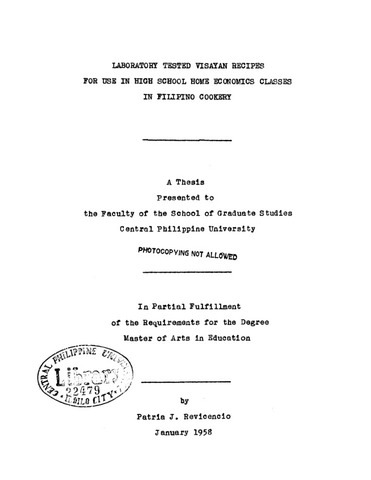Laboratory tested Visayan recipes for use in high school home economics classes in Filipino cookery
| dc.contributor.adviser | Nelson, Linnea A. | |
| dc.contributor.author | Revicencio, Patria J. | |
| dc.date.accessioned | 2022-03-22T01:47:36Z | |
| dc.date.available | 2022-03-22T01:47:36Z | |
| dc.date.issued | 1958 | |
| dc.identifier.citation | Revicencio, P. J. (1958). Laboratory tested Visayan recipes for use in high school home economics classes in Filipino cookery (Unpublished Master’s thesis). Central Philippine University, Jaro, Iloilo City. | en_US |
| dc.identifier.uri | https://hdl.handle.net/20.500.12852/2002 | |
| dc.description | Introduction | en_US |
| dc.description.abstract | Statement of the problem. Educators recognize that Home Economics is a rich field and has great potential values as a functional program since it is concerned with all that affects immediate and personal family living. Because of this, home economics has been a required subject in both public and private schools throughout the Philippines for quite a number of years. Secondary schools, however, have just begun to see the value of a functional approach to education, and to recognize the importance of home-life situations. Since schools are shifting their emphasis from subject matter to activities of everyday living, home economics faces an unusual opportunity to enrich the whole school program. The content of cookery courses as they are generally conducted has been severely criticized. Because of greater interest in foreign cookery, opportunities for native cookery have been extremely limited. The ingredients of most of the recipes prepared in foods laboratory classes are imported, either fresh or canned. Products of the locality are not extensively used. Many people are unaware of the wide variety of foods available locally that could be prepared tastefully and economically. By utilizing the community resources, one does not have to go far nor spend so much in order to cook appetizing balanced meals. One of the purposes of the organization to which all home economics students belong, the Future Homemakers of the Philippines, is to carry on the Filipino way of life and retain the cherished heritage in our basic culture. In line with "the community school principles in which materials and resources may be drawn from local life and environment for rich community development," the girls need to learn to make use of local materials. It is, therefore, the purpose of this study to standardize recipes often cooked and served in homes with the Idea of teaching these to students in their home economics cookery classes. By doing this, principles learned in schools could be carried over to homes and those practiced in homes could be carried over to the schools, thus bridging the gap which now exists between the two. | en_US |
| dc.format.extent | 129 leaves | en_US |
| dc.language.iso | en | en_US |
| dc.subject.ddc | GSL Theses 378.242 R32 | en_US |
| dc.subject.lcsh | Cooking, Philippine | en_US |
| dc.subject.lcsh | Cooking--Study and teaching (Secondary) | en_US |
| dc.subject.lcsh | Cooking | en_US |
| dc.subject.lcsh | Home economics--Study and teaching (Secondary) | en_US |
| dc.subject.lcsh | Recipes | en_US |
| dc.subject.lcsh | Philippines--Visayan Islands | en_US |
| dc.title | Laboratory tested Visayan recipes for use in high school home economics classes in Filipino cookery | en_US |
| dc.type | Thesis | en_US |
| dcterms.accessRights | Not publicly accessible | en_US |
| dc.description.bibliographicalreferences | Includes bibliographical references | en_US |
| dc.contributor.chair | Nelson, Linnea A. | |
| dc.contributor.committeemember | Chambers, Elizabeth | |
| dc.contributor.committeemember | Cabalfin, Epifanio S. | |
| dc.contributor.committeemember | Larsen, Almus O. | |
| dc.contributor.committeemember | Catedral, Alfredo P. | |
| dc.contributor.department | School of Graduate Studies | en_US |
| dc.description.degree | Master of Arts in Education | en_US |


